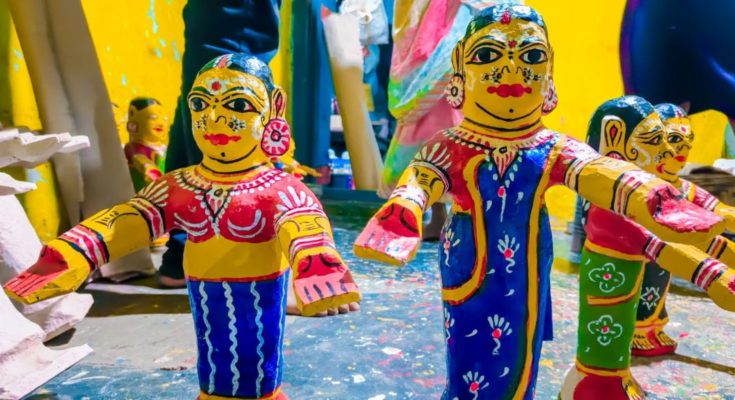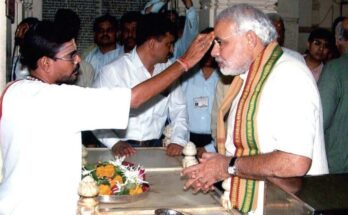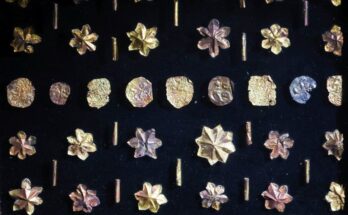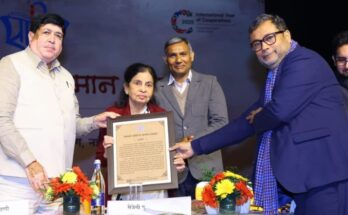Wooden Taa’Poi Dolls: The legend of Taa’Poi is a primordial Odia folk narrative which is sung during ‘Khudurukuni Osha’ also known as “Bhalukuni Osha”. This festival and the rituals are reflective of Odisha’s glorious maritime history and trading culture and portrays the medieval Kalingans’ great expertise in sea voyage and trade links across the South-East Asian islands.
Khudurukuni Osha rituals are based on the legend of a young girl named Taa’Poi, the only daughter of a rich merchant mariner. She had seven brothers, all of whom were seafarers. Her brothers sailed away to distant shores, leaving her alone with their wives; her sisters-in-law. The villainous sisters-in-law made her undergo a lot of sufferings, depriving her of food. She was made to do all the menial work and had to survive on Khuda (rice husk).
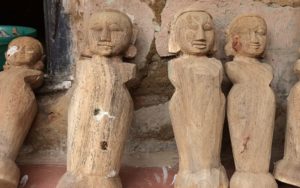
The evil sisters-in-law met their nemesis when the brothers returned and punished them for their misdeeds. Goddess Mangala is worshipped by young girls and the evening rituals include the singing of episodes from the life of Taa’Poi. In some villages, wooden images of Taa’Poi are worshipped along with the Goddesses.
The riverside village of Manapur, near Badamba has been making these dolls since centuries. Although the craft has nearly disappeared, a few families are trying hard to continue with the tradition. The dolls lack modern sophistication but preserve in themselves a rustic beauty. Once a thriving tradition, only four families are presently engaged in this dying craft. Carved out from a block of lightwood, the lovely dolls are painted in bright colours.
The tedious process of making these dolls starts a good six months away from the festival. The logs are sourced, cut into proper sizes, rough images are chiseled and kept to dry in the summer heat. The cracks are sealed with mud from the Mahanadi, a paste of tamarind seeds is applied. Each one is hand coloured by the women folk. The craftsmen get only a pittance for their hard labour, as they are sold only in the surrounding villages.
But like most traditional handicrafts, the wooden dolls of Manpur too have fallen on bad days. Along with the change in lifestyle, an influx of plastic and machine-made dolls have doomed our traditional woodcraft. The younger generation is just not interested in this trade, it is laborious and fetches little returns.
INTACH is undertaking a project to document and revive this age old tradition which is fast dying. Thankfully, a few months back, the wooden doll makers of Manpur got a fresh lease of life when the craft was discovered by Intach during the survey of the Heritage of the Mahanadi Valley. Under the aegis of Deepak Kumar Nayak and Anil Dhir, Intach is extending help to the craftsmen by way of marketing the dolls. INTACH is also transforming the craftsperson to adapt natural colours like they have done for centuries. They are being taught to make souvenirs, gift items, toys, masks etc. apart from the traditional dolls, which are a seasonal affair.
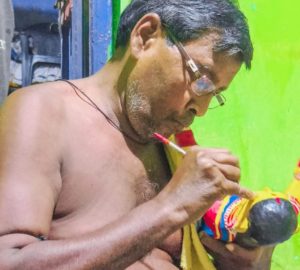
The artisan live is a small street flanked by single-storeyed mud and brick huts, some of them with an open front courtyard, stacked with the wooden handicrafts. Visitors can watch the making of the carved wooden figurines. Whole families are engaged in the art – usually the men are skilled in wood carving and the women do the colouring and polishing.
Intach has written to the Government to promote these wooden dolls in the various Utkalika showrooms and other emporiums. An Annual Wooden Dolls Fair should be organised along with initiatives to develop a Rural Craft Hub at Manpur. Intach is also sending the report to UNESCO to include it in the heritage map.

